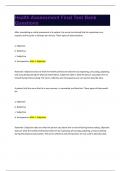Health Assessment Final Test Bank
Questions
After completing an initial assessment of a patient, the nurse has charted that his respirations are
eupneic and his pulse is 58 beats per minute. These types of data would be:
a. Objective
b. Reflective
c. Subjective
d. Introspective -ANS a. Objective
Rationale: Objective data are what the health professional observes by inspecting, percussing, palpating,
and auscultating during the physical examination. Subjective data is what the person says about him or
herself during history taking. The terms reflective and introspective are not used to describe data.
A patient tells the nurse that he is very nervous, is nauseated, and feels hot. These types of data would
be:
a. Objective
b. Reflective
c. Subjective
d. Introspective -ANS c. Subjective
Rationale: Subjective data are what the person says about him or herself during history taking. Objective
data are what the health professional observes by inspecting, percussing, palpating, and auscultating
during the physical examination. The terms reflective and introspective are not used to describe data.
,When listening to a patients breath sounds, the nurse is unsure of a sound that is heard. The nurses next
action should be to:
a. Immediately notify the patients physician
b. Document the sound exactly as it was heard
c. Validate the data by asking a coworker to listen to the breath sounds
d. Assess again in 20 minutes to note whether the sound is still present -ANS c. Validate the data by
asking a coworker to listen to the breath sounds
Rationale: When unsure of a sound heard while listening to a patients breath sounds, the nurse
validates the data to ensure accuracy. If the nurse has less experience in an area, then he or she asks an
expert to listen.
The patients record, laboratory studies, objective data, and subjective data combine to form the:
a. Data base
b. Admitting data
c. Financial statement
d. Discharge summary -ANS a. Data base
Rationale: Together with the patients record and laboratory studies, the objective and subjective data
form the data base. The other items are not part of the patients record, laboratory studies, or data.
The nursing process is a sequential method of problem solving that nurses use and includes which
steps?
,a. Assessment, treatment, planning, evaluation, discharge, and follow-up
b. Admission, assessment, diagnosis, treatment, and discharge planning
c. Admission, diagnosis, treatment, evaluation, and discharge planning
d. Assessment, diagnosis, outcome identification, planning, implementation, and evaluation -ANS d.
Assessment, diagnosis, outcome identification, planning, implementation, and evaluation
Rationale: The nursing process is a method of problem solving that includes assessment, diagnosis,
outcome identification, planning, implementation, and evaluation.
Barriers to incorporating EBP include:
a. Nurses lack of research skills in evaluating the quality of research studies
b. Lack of significant research studies
c. Insufficient clinical skills of nurses
d. Inadequate physical assessment skills -ANS a. Nurses lack of research skills in evaluating the quality of
research studies
Rationale: As individuals, nurses lack research skills in evaluating the quality of research studies, are
isolated from other colleagues who are knowledgeable in research, and often lack the time to visit the
library to read research. The other responses are not considered barriers.
, The nurse is reviewing data collected after an assessment. Of the data listed below, which would be
considered related cues that would be clustered together during data analysis? Select all that apply.
a. Inspiratory wheezes noted in left lower lobes
b. Hypoactive bowel sounds
c. Nonproductive cough
d. Edema, +2, noted on left hand
e. Patient reports dyspnea upon exertion
f. Rate of respirations 16 breaths per minute -ANS a. Inspiratory wheezes noted in left lower lobes
c. Nonproductive cough
e. Patient reports dyspnea upon exertion
f. Rate of respirations 16 breaths per minute
Rationale: Clustering related cues help the nurse recognize relationships among the data. The cues
related to the patients respiratory status (e.g., wheezes, cough, report of dyspnea, respiration rate and
rhythm) are all related. Cues related to bowels and peripheral edema are not related to the respiratory
cues.
The nurse is conducting an interview. Which of these statements is true regarding open-ended
questions? Select all that apply.




